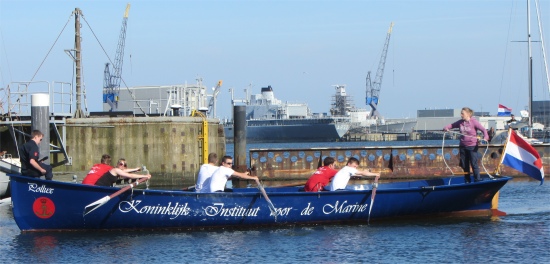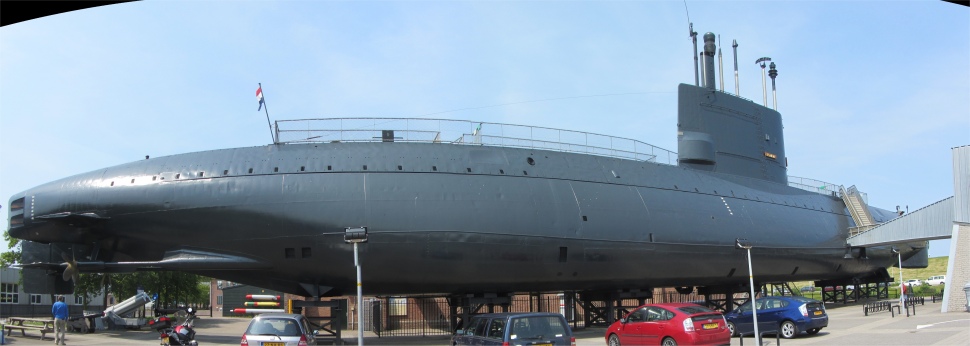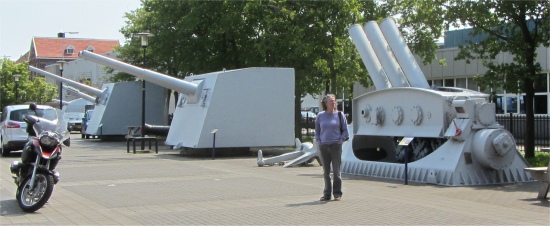 Youngsters in Training for Den Helder Tall Ships Festival |
It was quite appropriate for the Maritime Museum, also known as the Dutch Navy Museum, to be located at the home base of the Dutch navy. The museum is dedicated mainly to the history of the Royal Netherlands Navy, who gained their "Royal" status after the Netherlands became a kingdom in 1815. A fascinating glimpse of the complete history of the Royal Dutch Navy, since its establishment some 500 years ago, was displayed in the main building. The exhibition contained paintings, naval guns, uniforms and scale-models of several ships.
 Submarine Tonijn |
 Big Guns |
Tonijn, a submarine with a length of 78m, stood completely out of water, and was an impressive sight, almost dominating the museum in its size. It served between 1960 and 1991, and is the only Dutch submarine on permanent display to the public. Tonijn belonged to the Dolfijn class submarines of the Royal Netherlands Navy, a class of four submarines: the Dolfijn, Zeehond, Potvis and Tonijn. These were built in the late 1950s and the early 1960s, and were the first indigenous submarines built for the Netherlands Navy after World War II.
 Abraham Crijnssen |
The other two ships floated in Willemsoord harbour, a large former dockyard of the Royal Netherlands Navy. The minesweeper Abraham Crijnssen was one of eight Jan van Amstel steel class mine warfare vessels built for the Royal Netherlands Navy between 1936 and 1939. Named after the naval hero who conquered Surinam in 1668, the Abraham Crijnssen was officially commissioned in 1937. At the outbreak of the Pacific war (1941) Abraham Crijnssen and several of her sister ships were operating in the Netherlands East Indies. By February 1942 the situation in Java had become critical as Japanese forces gained air superiority and control of the sea. In the face of crushing naval defeats during the Battles of the Java Sea and Sunda Strait a general evacuation was ordered and the remaining Allied vessels began to withdraw in an attempt to reach Australia. Pieter De Bitter was scuttled at Sourabaya on 2nd March to prevent her from falling into Japanese hands, Eland Dubois was scuttled on 8th March and Jan Van Amstel was sunk by the Japanese destroyer Arashio on the same day following an unsuccessful attempt to break through the Lombok Strait into the Indian Ocean. Only Abraham Crijnssen succeeded in escaping, and only by sailing close to the coast at night and hiding, camouflaged with trees and foliage, by day. She eventually reached Fremantle on 20th March 1942. She was the last vessel to successfully escape from Java.
 Schorpioen |
Built in France, the ram ship Schorpioen started its active service in 1868. Typical for this type of ship are the ram and the use of iron cladding to protect the ship's skin. Although rams were no longer considered effective at the time, the use of protective iron cladding was. The purpose of HNLMS Schorpioen was to defend coastal waters and harbours. Because The Netherlands did not participate in any conflicts between 1868 and 1940, Schorpioen was never confronted with hostile actions. However, she almost sank a vessel and was actually sunk herself. In August 1868, a barkentine accidentally hit Schorpioen's bow and barely managed to ground herself before foundering. In 1886, Schorpioen was hit in the stern quarter by a paddle steam tug and sank in two hours. Evidently, one did not need a ram bow to successfully ram another vessel. She was raised and repaired.
 Bridge and Control Tower from De Ruyter |
Another building contained more naval artefacts and manufacturing exhibits. Details of navigational and communication systems were displayed with lots of hand-on equipment to keep us amused, together with an exhibit demonstrating the Dutch naval involvement in international crisis, particularly the Somali pirate issues.
In the grounds, the bridge and gun turret from Hr Ms De Ruyter (F806) were preserved. Named after Admiral Michiel de Ruyter, who defeated the Spanish, Swedish, French and English in a series of daring exploits, the guided missile /air defence frigate served from 1976 to 2001. The bridge and command centre were still fully equipped including the huge radar dome. This excellent exhibit gave a glimpse of the high tech state that had been reached in recent years, noticeably the use of 3D radar for detecting multiple targets.
For Rex and I, this was a really excellent day, though Meryl was starting to run out of steam after 5 hours. We left after 7 hours, having certainly got our money's worth. In the evening the Belgium boat I had spotted entering the harbour, 24 hours earlier, was departing. The crew gave me a wave, so no hard feelings then.
